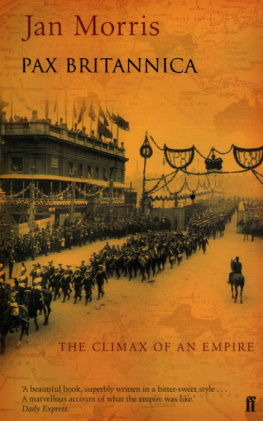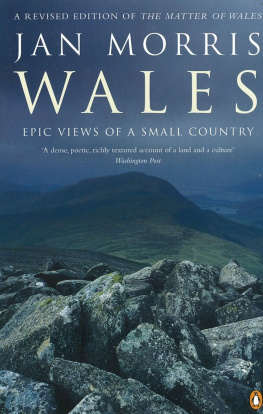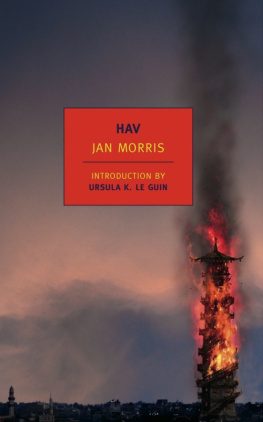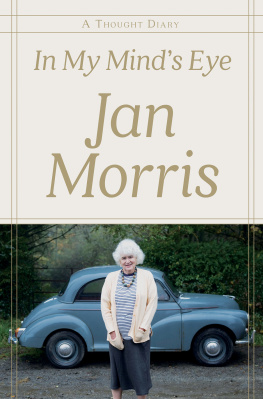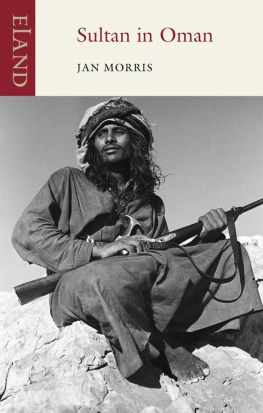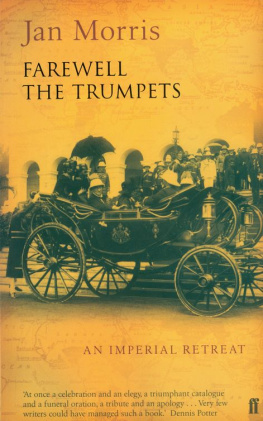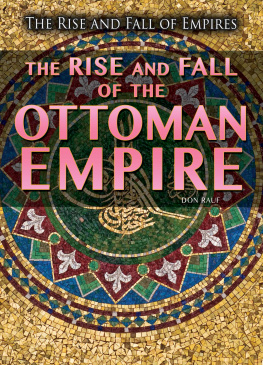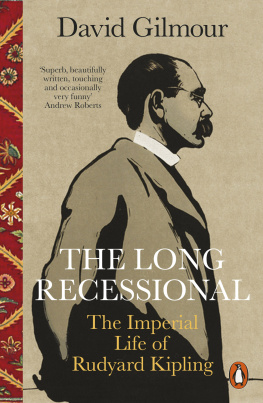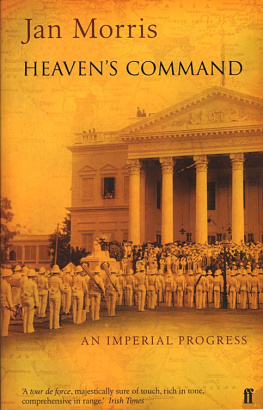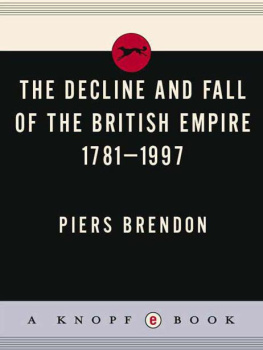Jan Morris - Climax of an Empire
Here you can read online Jan Morris - Climax of an Empire full text of the book (entire story) in english for free. Download pdf and epub, get meaning, cover and reviews about this ebook. year: 1999, publisher: Faber Faber Inc, genre: History. Description of the work, (preface) as well as reviews are available. Best literature library LitArk.com created for fans of good reading and offers a wide selection of genres:
Romance novel
Science fiction
Adventure
Detective
Science
History
Home and family
Prose
Art
Politics
Computer
Non-fiction
Religion
Business
Children
Humor
Choose a favorite category and find really read worthwhile books. Enjoy immersion in the world of imagination, feel the emotions of the characters or learn something new for yourself, make an fascinating discovery.
- Book:Climax of an Empire
- Author:
- Publisher:Faber Faber Inc
- Genre:
- Year:1999
- Rating:3 / 5
- Favourites:Add to favourites
- Your mark:
- 60
- 1
- 2
- 3
- 4
- 5
Climax of an Empire: summary, description and annotation
We offer to read an annotation, description, summary or preface (depends on what the author of the book "Climax of an Empire" wrote himself). If you haven't found the necessary information about the book — write in the comments, we will try to find it.
Climax of an Empire — read online for free the complete book (whole text) full work
Below is the text of the book, divided by pages. System saving the place of the last page read, allows you to conveniently read the book "Climax of an Empire" online for free, without having to search again every time where you left off. Put a bookmark, and you can go to the page where you finished reading at any time.
Font size:
Interval:
Bookmark:
For
TOM MORRIS
tea-time imperialist
SetinthisstormyNorthernsea,
Queenoftheserestlessfieldsoftide,
England!whatshallmensayof thee,
Beforewhosefeettheworldsdivide?
O SCAR W ILDE
This book, though self-contained, forms the centre-piece of a trilogy about the rise, climax and fall of the Victorian Empire. It is specifically concerned with the climax, as exemplified and dramatized by Queen Victorias Diamond Jubilee in 1897.
When I wrote it, in the 1960s, there were people still alive who remembered that spectacularly theatrical event, and the immense world-wide dominion which it represented my own mother was one, and recalled the sailor-caps emblazoned with the names of Royal Navy battleships which she and her brother had worn to celebrate the occasion. Today it seems to most Britons almost a matter of myth: the aged Queen so very nearly divine, the British Empire sprawled across all the worlds continents, the immense muddle of motives good and bad which were the impulses of imperialism, the aura of power, wealth and majesty which surrounded the very name of Britain at the end of the nineteenth century. Was that really us?, British citizens of another fin-de-sicle might well ask themselves.
But it was, and in trying to evoke the feeling of Britishness in 1897, as it was manifested throughout the globe, I have not tried to hide my own astonishment. The book is a microcosm of its subject, but also a record of ones citizens own responses a couple of generations later. It is a kind of historical travel book or reportage, and I have not tried to conceal, either, a sensual sympathy for the period, haunted as it is in retrospect by our knowledge of tragedies to come for soon after the Diamond Jubilee the miseries of the Boer War cracked the imperial spirit, and still more terrible events would presently destroy it.
In 1997, the centenary of the Diamond Jubilee, as it happened, was marked by the British withdrawal from the very last of the great colonial possessions, Hong Kong, but by then the frisson of imperial achievement had long since evaporated. In this book I try to revive it. I have fondly imagined the work orchestrated by the young Elgar, and illustrated by Frith; its pages are perfumed for me with saddle-oil, joss-stick and railway steam; I hope my readers will feel, as they close its pages, that they have spent a few hours looking through a big sash window at a scene of immense variety and some splendour, across whose landscapes there swarms a remarkable people at the height of its vigour, in an outburst of creativity, pride, greed and command that has affected all our lives ever since.
TREFAN MORYS, 1998
The Diamond Jubilee of Queen Victoria, its celebration as a festival of Empire and the explosion of national emotion known as the New Imperialism page
The extent of the British Empire at its climax, and something of its tangled origins page
The shipping routes, mails and cables that bound the British possessions together page
How the existence of the British Empire disseminated seed and stock across the world page
An imperial frontier town: Salisbury, Rhodesia page
The first incentive of imperialism: gain page
Secondary motives: aspects of glory, aggressive, defensive, romantic, evangelist and plain patriotic page
Attitudes of the British towards their subject peoples, and reasons for the aloofness that was fundamental to their method page
An island fortress: St Lucia in the Windward Islands page
The theoretical structure of Empire, its basic system and its laws page
Exceptions, anomalies and complications of Empire, from larrikins to Lord Cromer page
The run of Empire-builders: their type, look and social aspirations page
Two explorers, three soldiers, an admiral, two administrators, two politicians, a couple of adventurers and a Queen page
Simla and the British Government of India page
Some pleasures of Empire, sporting and social page
Adventure: living dangerously and dying young page
Imperial architecture, sacred and secular, with parks and gardens too page
Imperial muses: painting, sculpture, literature, music and intimations of folk-art page
The British Empire as a development agency: irrigation, roads, railways, mapping, medicine and a specimen millennium page
A self-governing colony of the Empire: Canada page
The armies of the Crown, British and Indian: their past glories and their present weaknesses page
Splendours and absurdities of the Royal Navy, with glimpses of lan page
Spoils and influences of Empire, and what they did for England page
The Other Island: Ireland page
Troubles of Empire and possible threats to its future, with plans for evading them page
Did the British Empire have an ideology? Religion, Englishness, imperial monarchy, radicalism and Fair Play page
Queen Victoria writes up her diary, the British survey their position in the world, and we bring the Empire to a close page
page
page
I N E UROPE : Great Britain and Ireland: Channel Islands: Gibraltar: Isle of Man: Malta
I N A FRICA : Ashanti: Basutoland: Bechuanaland: British East Africa: Cape Province: Gambia: Gold Coast: Natal: Nigeria: Nyasaland: Rhodesia: Sierra Leone: Somaliland: Uganda: Zanzibar
I N A MERICA : Bahamas: Barbados: British Guiana: British Honduras: British Virgin Islands: Canada: Falkland Islands: Jamaica: Leeward Islands: Newfoundland: Tobago: Trinidad: Turks and Caicos Islands: Windward Islands
I N A SIA : Aden: Brunei: Ceylon: Hong Kong: India: Labuan: Malay Federated States: North Borneo: Papua: Sarawak: Singapore
I N A USTRALASIA : New South Wales: New Zealand: Queensland: South Australia: Tasmania: Victoria: Western Australia
I N THE A TLANTIC O CEAN : Ascension: Bermuda: St Helena: Tristan da Cunha
I N THE I NDIAN O CEAN : Mauritius: Seychelles: seven other groups and islands
I N THE P ACIFIC O CEAN : Ellice, Gilbert, Southern Solomon, Union groups: Fiji: Pitcairn: twenty-four other groups, islands and reefs
Transvaal was debatably subject to British suzerainty: Egypt was under British military occupation : Cyprus was British-administered, but nominally under Turkish sovereignty
Area: about 11m square miles
Population: about 372m
ButhushtheNationscomefromoverseas,
Attend,withtrumpetsblownandflagsunfurled,
ToswellthyJubileeofJubilees,
HeartoftheWorld!
Cosmo Monkhouse
Punch, June 26, 1897
B ERORE she set out on her Diamond Jubilee procession, on the morning of June 22, 1897, Queen Victoria of England went to the telegraph room at Buckingham Palace, wearing a dress of black moir with panels of pigeon grey, embroidered all over with silver roses, shamrocks and thistles. It was a few minutes after eleven oclock. She pressed an electric button; an impulse was transmitted to the Central Telegraph Office in St Martins le Grand; in a matter of seconds her Jubilee message was on its way to every corner of her Empire.
It was the largest Empire in the history of the world, comprising nearly a quarter of the land mass of the earth, and a quarter of its population. Victoria herself was a Queen-Empress of such aged majesty that some of her simpler subjects considered her divine, and slaughtered propitiatory goats before her image. The sixtieth anniversary of her accession to the throne was being celebrated as a festival of imperial strength, splendour and unitya mammoth exhibition of power, in a capital that loved things to be colossal. Yet the Queens message was simple
Font size:
Interval:
Bookmark:
Similar books «Climax of an Empire»
Look at similar books to Climax of an Empire. We have selected literature similar in name and meaning in the hope of providing readers with more options to find new, interesting, not yet read works.
Discussion, reviews of the book Climax of an Empire and just readers' own opinions. Leave your comments, write what you think about the work, its meaning or the main characters. Specify what exactly you liked and what you didn't like, and why you think so.

